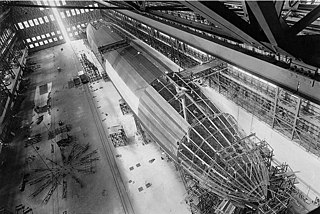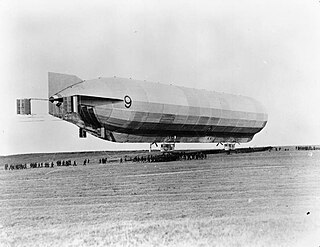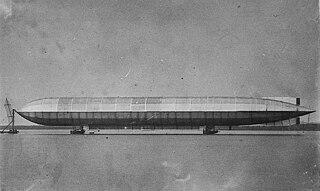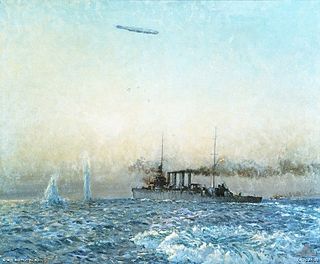Related Research Articles

A Zeppelin is a type of rigid airship named after the German Count Ferdinand von Zeppelin who pioneered rigid airship development at the beginning of the 20th century. Zeppelin's notions were first formulated in 1874 and developed in detail in 1893. They were patented in Germany in 1895 and in the United States in 1899. After the outstanding success of the Zeppelin design, the word zeppelin came to be commonly used to refer to all rigid airships. Zeppelins were first flown commercially in 1910 by Deutsche Luftschiffahrts-AG (DELAG), the world's first airline in revenue service. By mid-1914, DELAG had carried over 10,000 fare-paying passengers on over 1,500 flights. During World War I, the German military made extensive use of Zeppelins as bombers and as scouts, killing over 500 people in bombing raids in Britain.

A blimp, or non-rigid airship, is an airship (dirigible) or barrage balloon without an internal structural framework or a keel. Unlike semi-rigid and rigid airships, blimps rely on the pressure of the lifting gas inside the envelope and the strength of the envelope itself to maintain their shape.

An airship or dirigible balloon is a type of aerostat or lighter-than-air aircraft that can navigate through the air under its own power. Aerostats gain their lift from a lifting gas that is less dense than the surrounding air.
A parasite aircraft is a component of a composite aircraft which is carried aloft and air launched by a larger carrier aircraft or mother ship to support the primary mission of the carrier. The carrier craft may or may not be able to later recover the parasite during flight.

A rigid airship is a type of airship in which the envelope is supported by an internal framework rather than by being kept in shape by the pressure of the lifting gas within the envelope, as in blimps and semi-rigid airships. Rigid airships are often commonly called Zeppelins, though this technically refers only to airships built by the Luftschiffbau Zeppelin company.

The 23 class were rigid airships produced in the United Kingdom during the First World War. They were designed by Vickers, who also built the first and last of the four ships. The other two were built by William Beardmore and Company and Armstrong-Whitworth. While the 23 class airships were never used in combat, the four ships provided many hours of valuable training and experimental data for British airship crews and designers. Although a total of 17 of these ships were contemplated at one time, only four were ever built. The 23 class was found to be significantly overweight, leading to its cancellation in favour of the more-refined R23X class.

HMA No. 9r was a rigid airship designed and built by Vickers at Walney Island just off Barrow-in-Furness, Cumbria. It was ordered in 1913 but did not fly until 27 November 1916 when it became the first British rigid airship to do so. It was dismantled in June 1918 after being flown for around 165 hours, mainly for experimental purposes.
Vickers Limited was a British engineering conglomerate. The business began in Sheffield in 1828 as a steel foundry and became known for its church bells, going on to make shafts and propellors for ships, armour plate and then artillery. Entire large ships, cars, tanks and torpedoes followed. Airships and aircraft were added, and Vickers jet airliners were to remain in production until 1965.

The SSZ non-rigid airships or "blimps" were developed in United Kingdom during World War I from the earlier SS class. The main role of these craft was to escort convoys and scout or search for German U-Boats. A secondary purpose was to detect and destroy mines.
The best known German strategic bombing campaign during World War I was the campaign against Britain, although strategic bombing raids were carried out or attempted on other fronts. The main campaign against Britain started in January 1915 using airships. From then until the end of World War I the German Navy and Army Luftstreitkräfte mounted over 50 bombing raids on the United Kingdom. These were generally referred to as "Zeppelin raids": although both Zeppelin and Schütte-Lanz airships were used, the Zeppelin company was much better known and was responsible for producing the majority of the airships used. Weather conditions and night flying conditions made airship navigation and maintaining bombing accuracy difficult. Bombs were often dropped miles off target and accurate targeting of military installations was impossible. The civilian casualties made the Zeppelins an object of hatred, and they were dubbed "baby-killers". With the development of effective defensive measures the airship raids became increasingly hazardous, and in 1917 the airships were largely replaced by aeroplanes.

The Astra-Torres airships were non-rigid airships built by Société Astra to a design by Spaniard Leonardo Torres Quevedo in France between about 1908 and 1922. They had a highly-characteristic tri-lobed cross-section rather than the more usual circular cross-section. This was the result of moving most of the blimp's bracing wires inside the envelope in an attempt to minimise drag. Early Astra-Torres airships could be trimmed by moving the entire gondola fore-and-aft.

His Majesty's Airship No. 1 was designed and built by Vickers, Sons and Maxim at their works in Barrow-in-Furness, Lancashire, England, as an aerial scout airship for the Royal Navy. It was the first British rigid airship to be built, and was constructed in a direct attempt to compete with the German airship programme. Often referred to as "Mayfly", a nickname given to it by the lower deck, in public records it is designated ‘HMA Hermione’ because the naval contingent at Barrow were attached to HMS Hermione, a cruiser moored locally preparing to act as its tender.

The British R23X class of rigid airships were developed during World War I using the experiences gained from the 23 class, but only two of the planned four R23X class were built: R27 and R29. Both were completed mid-1918, but just two-and-a-half months after entering service R27 was destroyed by fire in a hangar; while R29 went on to become the most successful British wartime rigid airship, being the only one to meet enemy action, as well as the only one to sink a submarine.

SSclass airships were simple, cheap and easily assembled small non-rigid airships or "blimps" that were developed as a matter of some urgency to counter the German U-boat threat to British shipping during World War I. A secondary purpose was to detect and destroy mines. The class proved to be versatile and effective, with a total of 158 being built in several versions.

The Action of 4 May 1917 was a naval and air engagement of the First World War in the North Sea. The action took place between the German Zeppelin LZ 92, several German submarines and a naval force led by the Australian light cruiser HMAS Sydney. The action was inconclusive with no casualties on either side, concluding when the Zeppelin had dropped all of its bombs and the cruisers had expended all of their anti-aircraft ammunition.

The convoy—a group of merchantmen or troopships traveling together with a naval escort—was revived during World War I (1914–18), after having been discarded at the start of the Age of Steam. Although convoys were used by the Royal Navy in 1914 to escort troopships from the Dominions, and in 1915 by both it and the French Navy to cover their own troop movements for overseas service, they were not systematically employed by any belligerent navy until 1916. The Royal Navy was the major user and developer of the modern convoy system, and regular transoceanic convoying began in June 1917. They made heavy use of aircraft for escorts, especially in coastal waters, an obvious departure from the convoy practices of the Age of Sail.

The Beta 1 was a non-rigid airship constructed for experimental purposes in the United Kingdom by the Army Balloon Factory in 1910. Reconstructed as Beta II, it was used successfully by the British Army and then by the Royal Naval Air Service as HMA No.17, and was finally struck off charge in 1916.

Delta was a British airship built for initially the British Army and later acquired by the Royal Navy (RN).
References
- ↑ Castle, Ian; Bryan, Tony (19 May 2009). British airships, 1905-30 . Osprey Pub. pp. 13–14. ISBN 978-1846033872.
| This aircraft-related article is a stub. You can help Wikipedia by expanding it. |